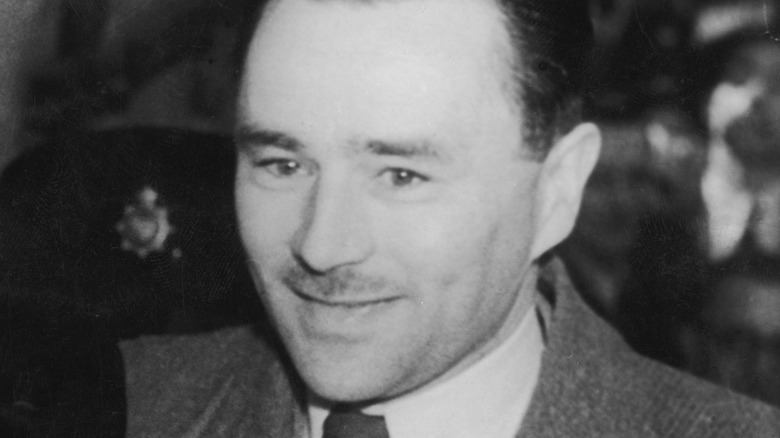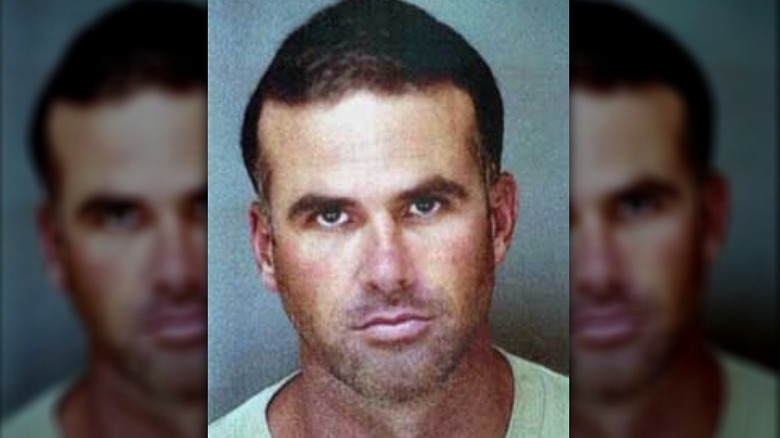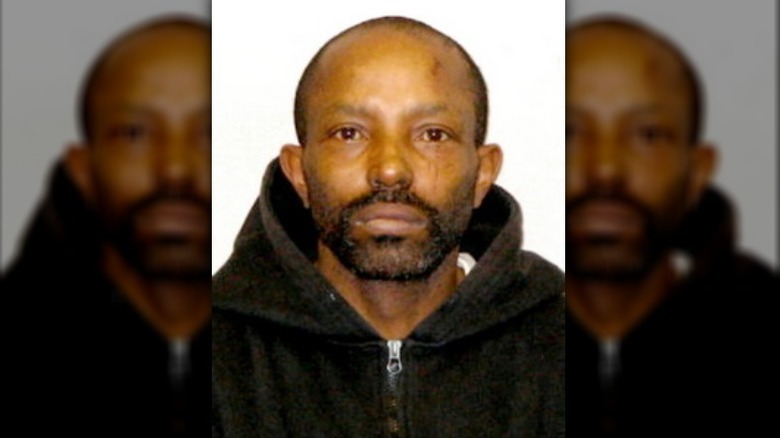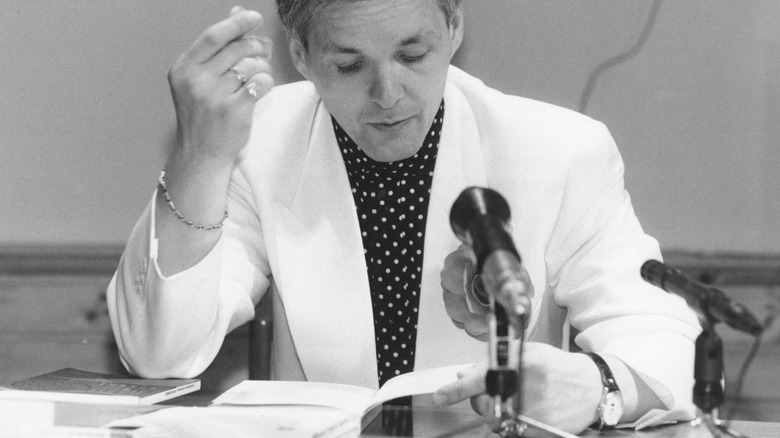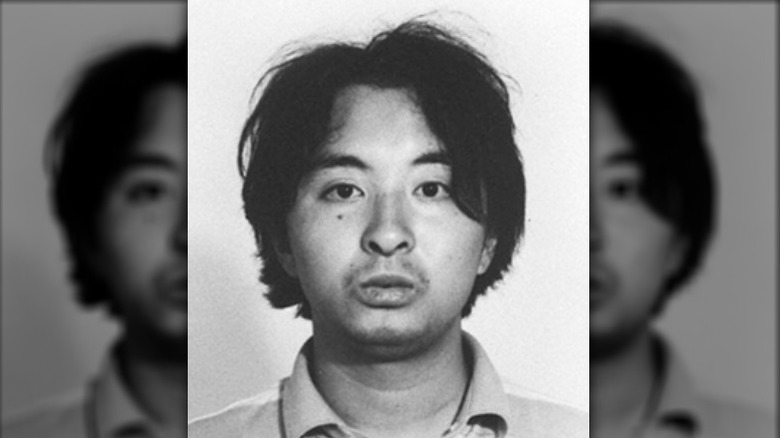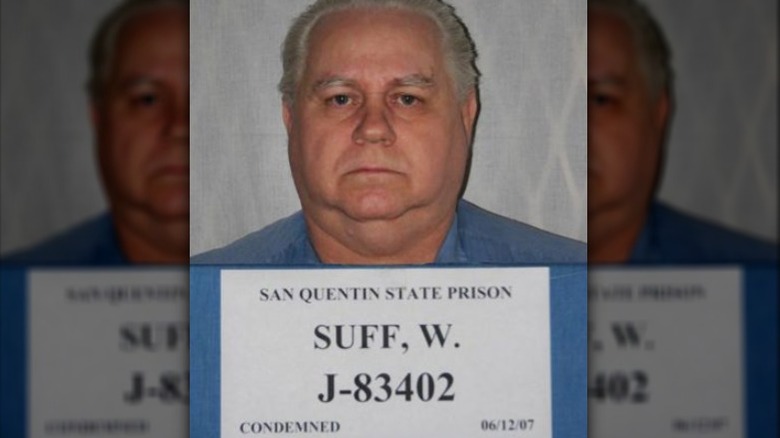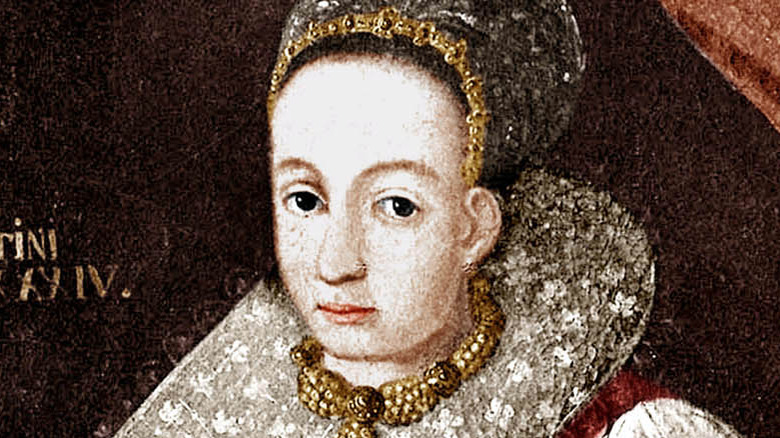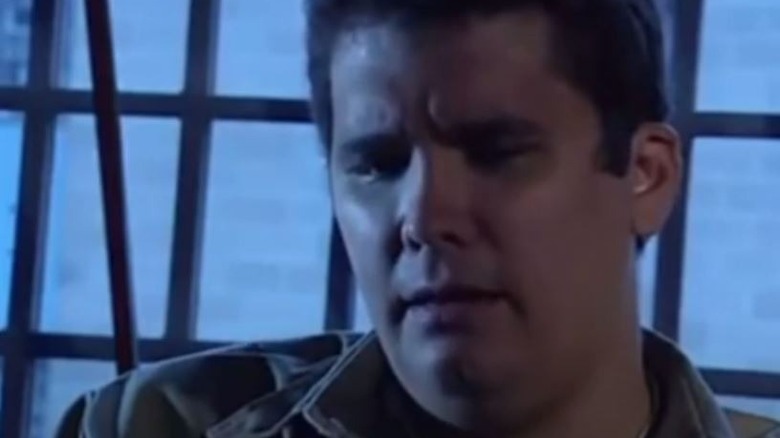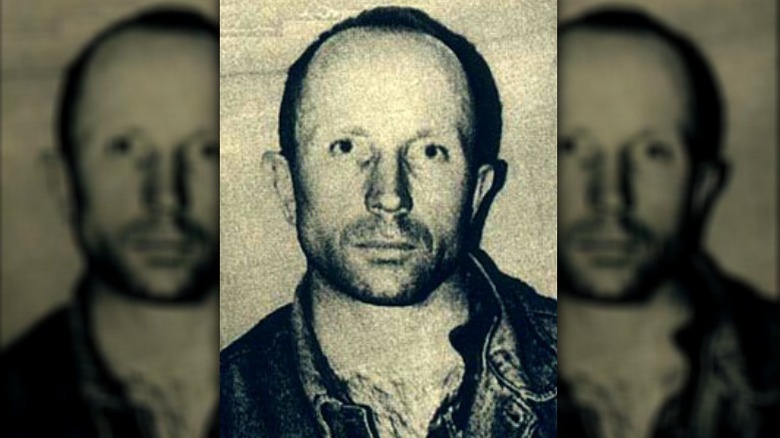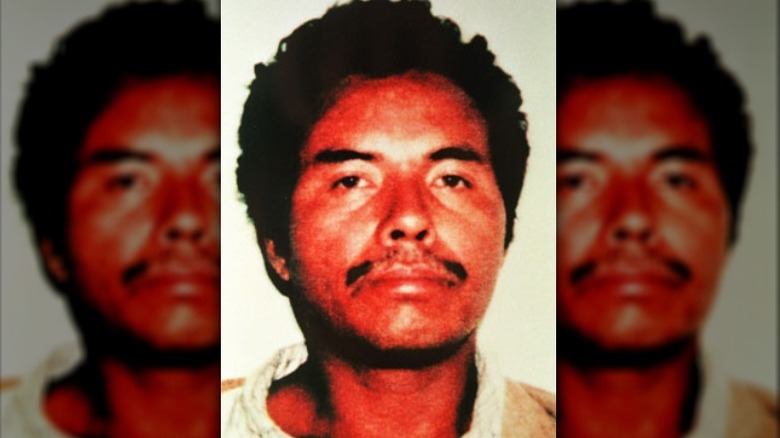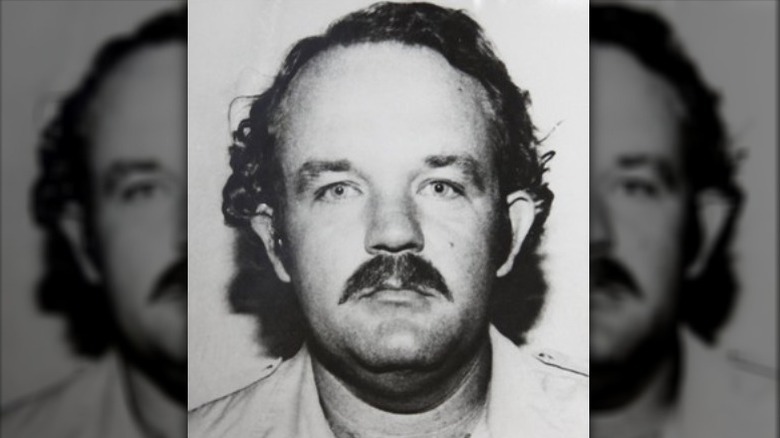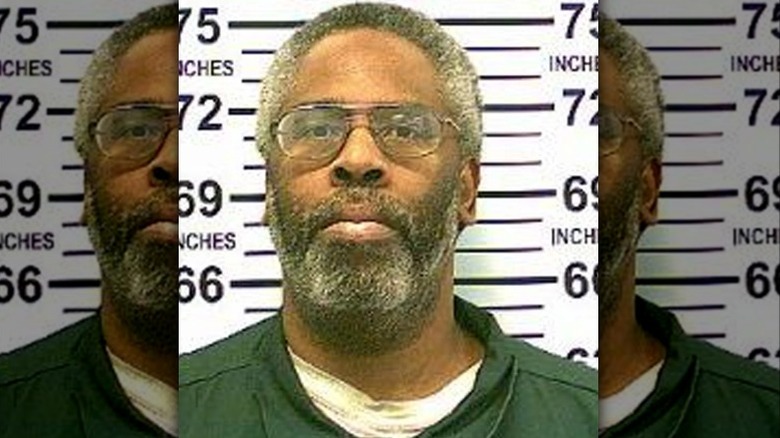Some Of The Most Famous Serial Killers Who Were Leos
It is unclear how often people correlate horoscopes and serial killers, but there is an interesting link between them. There are actually several zodiac signs that seem to be a common denominator in producing a lot of serial killers. Some of the most prolific ones are Leos, per Ranker. According to a recent study performed by a noted astrologist, nearly every sign has proved capable of producing killers, especially serial ones, says Wicked Local.
Each sign has its own characteristics that can explain why that particular zodiac would commit a crime. Of the 12 zodiac signs, four top the list with the most serial killers: Cancer, Pisces, Scorpio, and Sagittarius. So where does Leo rank? It actually ranks ninth, per an infographic by Astrology Zodiac. The Leo sign is also ranked eighth in the number of victims per sign. But who are some famous killers that are Leos, and how do they compare?
John George Haigh
John George Haigh might not be the most immediately recognizable name, but he's not entirely unknown in popular culture. He was the central character in the 2002 TV movie "A is for Acid," played by "British Men Behaving Badly" star Martin Clunes (via IMDb). According to the BBC, he's also part of Madame Tussauds Chamber of Horrors in London.
As Jonathan Oates' book "John George Haigh, the Acid-Bath Murderer" tells us, Haigh was born on July 24, 1909, in Stamford, U.K. As the title indicates, the serial killer had a particularly grisly way of disposing of his victims' bodies in acid. A very small silver lining, they were already dead at that point. According to the Wakefield Express, Haigh also claimed a fascination with vampirism and may have drank the blood of his victims ... though this may have been a wildly unsuccessful con to plead insanity, per The History Press.
Haigh fell out of favor with his religious family after becoming a convicted fraudster, but he wasn't just any old London huckster. Instead, his tactics involved murdering his victims before selling whatever they owned. After killing at least six people in this fashion, Haigh was finally caught. He'd posed as an inventor, luring affluent victims into the "workshop" where he committed his crimes. The discovery of one victim's intact dentures on-site clued the police into his horrific actions, and Haigh was executed in 1949.
Cary Anthony Stayner
Cary Anthony Stayner wasn't just a serial killer, he was also the older brother of a famous kidnapping victim — his younger brother Steven Stayner, who spent years as the victim of a child abuser, was later sucked into a vortex of entertainment industry deals and media attention, and died in a traffic accident when he was just 24 (via The Independent).
Born on August 13, 1961, the Merced, California native felt that he lived in his younger brother's shadow. Unfortunately, this wasn't the case for long. In 1999, while working at the Cedar Lodge Motel near Yosemite National Park, Cary Stayner murdered four women in the area.
Understandably, members of the Stayner family were quite shocked when they found out they had a serial killer in the family. "When it came out that Uncle Cary was involved -– it kind of sideswipes you and it kind of knocks you to the point that you don't know what you feel or what you think," Steven Stayner's daughter, Ashley, said.
Cary Stayner was sentenced to death in 2002, but his story continues to have strange ripples. In 2022, the Los Angeles Times reported that a scammer from Sacramento, California, had stolen Stayner's identity to collect unemployment benefits.
Anthony Sowell
Cleveland, Ohio native Anthony Sowell was born on August 19, 1959, per the book "Crimes of the Centuries." According to The New York Times, he died in prison in 2021, after a decade on death row. In the intervening years, he became one of the most infamous criminals his hometown had ever seen.
As Cleveland.com tells us, Sowell — a former Marine and a convicted rapist — lived in the city's Mount Pleasant area, which had been suffering from an abominable stench that never seemed to go away. This was attributed to a local sausage factory (via CNN), but when the police visited Sowell while investigating an assault case, they stumbled onto the true reason for the smell: the man was hiding dead bodies in his home. Further investigations unveiled the true scale of the situation, as Sowell's property was hiding the remains of no less than 11 dead victims. He'd been preying on women who lived on the edge of society, luring them home before ruthlessly assaulting — and often killing — them.
Sowell's murders took place between 2007 and 2009, and he was sentenced to death in 2011. Meanwhile, the city of Cleveland faced its own reckoning. As it turned out, the marginalized nature of Sowell's victims meant that the police hadn't really investigated their disappearances, which led to multiple lawsuits and settlements.
Jack Unterweger
Johann "Jack" Unterweger hid his true nature behind a respected public facade. Per Biography, the Austrian killer (born August 16, 1950) was entirely illiterate when he went to jail for murdering a woman in 1976. In a few years, however, he became a great writer whose autobiography was not only published, but became a hit. As The New York Times reports, he soon became a cause célèbre among the country's cultural elite.
Unterweger was paroled in 1990 and reentered the world as a budding literary superstar. However, as Charlotte Greig and John Marlowe's book "Serial Killers & Psychopaths: True Life Cases that Shocked the World" tells us, the writer wasn't actually reformed in the slightest. On the contrary, he was secretly killing sex workers in Austria and the Czech Republic during his celebrity days, and even covered his own murders as a crime reporter.
Eventually, Unterweger traveled to the U.S., where he stayed in Los Angeles' notorious Cecil Hotel and committed three more murders (via People). Incidentally, the hotel has quite a reputation, as it's also connected to serial killer Richard Ramirez, as well as the Black Dahlia Murder. Cecil Hotel is also where Elisa Lam's strange death in 2013 happened.
Fortunately, the authorities soon figured out what Unterweger was up to, and he was arrested in 1992. He received a life sentence for nine murders in 1994, and died by suicide in his cell.
Tsutomu Miyazaki
In 1989, Japanese serial killer Tsutomu Miyazaki caused the country to take a long, hard look at itself, per the Los Angeles Times. Miyazaki specifically targeted young girls, killing four victims over the span of a year, and abusing their remains in numerous ways, per Victor McQueen's book "The World's Worst Serial Killers." He also enjoyed tormenting the victims' families with taunting messages, and even sent a package that contained clues and teeth. He was eventually caught while taking photos of another young girl, as ABC News reports.
The case was major news in Japan because of its extreme nature, but also because of its cultural implications. Miyazaki was an avid consumer of some of the most violent media the country had to offer, which — combined with the young age of his victims — sparked a fiery conversation about Japanese pop culture, portrayals of violence, and a tendency to focus on extremely young-looking female characters.
Miyazaki, whom some called the "Killer Nerd," was born on August 21, 1962. He was executed in 2008 (via the BBC), but his grim legacy hasn't been forgotten. In 2022, his story was a major part of Fuminori Nakamura's novel "My Annihilation" (per The New York Times).
If you or someone you know may be the victim of child abuse, please contact the Childhelp National Child Abuse Hotline at 1-800-4-A-Child (1-800-422-4453) or contact their live chat services.
William Lester Suff
According to Susan Hall's book "The World Encyclopedia of Serial Killers," William Lester Suff (aka Bill Lee Suff) is the kind of man who would — and, tragically, did — kill his own baby daughter. After getting parole in 1984, he soon continued to prove that prison hadn't taught him to respect human life. Suff, who was born on August 20, 1950, claimed at least 12 victims before getting caught in 1992. He targeted sex workers in Riverside County, California, and has been called "The Riverside Killer" as a result (per The New York Times).
Per the Los Angeles Times, Suff's crimes became more brutal as time went by. He was captured in January 1992 after an officer pulled over his car, and found incriminating evidence — including a literal bloody knife. As The New York Times reports, Suff was sentenced to death in October 1995, but the sentence hasn't been carried out. He was still on death row in 2019, when Governor Gavin Newsom put a moratorium on the state's death sentences (via Desert Sun).
Elizabeth Báthory
As Encyclopedia Britannica tells us, Countess Elizabeth Báthory was born on August 7, 1560. The Hungarian noblewoman was a massively prolific serial killer whose victim count can be measured by the hundreds. Per Biography, up to 650 victims have been attributed to her. Báthory's lengthy list of crimes isn't limited to "just" murder, either. She was also an expert torturer and fond of tormenting young women in a number of gruesome, generally deadly ways. Stories of the countess started making rounds around 1604, and in 1610, she was quietly placed on house arrest in Čachtice Castle.
While there's a fair amount of historical evidence that Báthory was a ruthless person, National Geographic notes the countess' true body count is almost certainly much smaller than the wildest estimations. Though there are plenty of witness reports about her murders and cruelty, some researchers believe the majority of those accounts are untrue, and the extent of her brutality may have been exaggerated to discredit her for various political and financial reasons. It's also worth noting that her most famous method of carnage — taking rejuvenating baths in the blood of her victims — is almost certainly untrue. After all, this famous addition to her dark reputation came long after she was dead.
Michael Bruce Ross
Michael Bruce Ross was born on July 26, 1961, per Christopher Berry-Dee's book "Talking with Serial Killers: Dead Men Talking." An educated man who studied at Cornell University, Ross started killing in the 1980s (via NBC News). He's thought to have killed as many as eight young women, but the long arm of the law had an extremely difficult time tracking him down.
Actually catching Ross and getting him to confess was relatively straightforward, and happened in the mid-1980s (per The New York Times). However, things became convoluted afterward. He was originally sentenced to death for four murders in Connecticut, but also confessed to additional murders. In 2011, he received an additional prison sentence in Orange County, California.
As CNN reports, Ross started actively seeking lethal injection after growing weary of death row. This was difficult because numerous parties opposed the serial killer's wish to hasten his own execution for various reasons. As such, Ross had to go through a lengthy process to prove that he was of sound mind. The attempt was ultimately successful, and in 2005, Ross became the first Connecticut inmate to be executed since 1960.
As a strange epilogue to the story, one mental health professional who opposed Ross' wish received a final letter from the serial killer after the execution. "Check, and mate," it read. "You never had a chance!"
Anatoly Onoprienko
Anatoly Onoprienko's father sent him to an orphanage after his mother's death, according to R.J. Parker's book "Serial Killers Encyclopedia." Onoprienko later became a burglar, and around 1989, found a terrifying outlet for his innate fury. Onoprienko started brutally killing the people he discovered in the houses and cars he decided to enter. According to The Guardian, he murdered 40 people in 1995 and 1996 alone, and had a total of 52 victims. After killing the people he found, he often looted their possessions and set fire to the building.
Onoprienko was born in Lasky, Ukraine, on July 25, 1959. He was known as "Terminator" — a fitting moniker, considering his utterly emotionless demeanor after his capture in 1996. Due to the cruelty of his many crimes and the widespread panic his reign of terror had caused, the public wanted Onoprienko executed. The serial killer himself agreed with the sentiment, but as it turns out, Ukraine had agreed to abolish the death sentence at this point. Onoprienko received a life sentence instead, and in 2013, he had a fatal heart attack in prison (per the Toronto Star).
Ángel Maturino Reséndiz
Ángel Maturino Reséndiz (b. August 1, 1959) is a strange case as serial killers go, because he was only ever convicted for one murder (per Nigel Cawthorne's book "World Serial Killers II"). However, news outlets like CBS News, ABC13, and San Antonio Express-News have been quite happy to use the serial killer moniker, and with a pretty decent reason. Reséndiz has been connected to at least 15 brutal murders (per CNN). Dubbed "The Railroad Killer," he used freight trains to get around, and jumped off to kill people with whatever means were available to him at the time. After searching the premises for food and supplies, he quickly left the scene the way he came.
Per CNN, Reséndiz — who was using an alias — was captured peacefully in 1999, when Texas Ranger Sgt. Drew Carter managed to negotiate his arrest using the killer's family as a mediator. Reséndiz was executed in Texas in 2006 (via the BBC).
David Alan Gore
David Alan Gore and Fred Waterfield were cousins who teamed up to stalk and assault young women, according to The Palm Beach Post. Gore murdered six of these victims between 1981 and 1983 (per Tampa Bay Times). After their crimes came out in the open, the two Florida natives became known as "The Killing Cousins."
Gore was caught in 1983 after an eyewitness alerted the authorities to his murder of an escaping victim. He was sentenced to death in 1984. Waterfield, who wasn't involved in all of the murders, received two life sentences the same year.
As "The Voices of Serial Killers" notes, Gore was born on August 21, 1953. He received a lethal injection on April 12, 2012, after 28 years on death row. Though he'd previously shown little regret and spent much of his time fighting his death sentence, he changed his tone mere minutes before his death. "I'm sorry. I've had remorse," the killer said before his execution. "I'm not the man I was back then. I don't fear death."
Kendall Francois
According to Poughkeepsie Journal, eight women disappeared in the Poughkeepsie, New York, area between 1996 and 1998. Their disappearances posed a massive problem for the police. "For two years, we were hunting a ghost," said William Siegrist, who worked as a detective during the investigation. "Nobody really knew what happened to these women. We had no crime scene, no bodies, no nothing — until the day we arrested Francois."
The "Francois" in question was one Kendall Francois, born on July 26, 1971, (per R.J. Parker's "Serial Killers Encyclopedia"). He lived in the area and worked as a school monitor, and had a rough reputation among the area's sex workers. After a prospective victim managed to escape Francois' assault and seek help, police officers searched his house on September 2, 1998. They soon found they had a serial killer on their hands, with Francois storing the bodies of his victims in his home.
Francois admitted his crimes in order to avoid a death sentence and in 2000, he received eight consecutive life sentences, per The New York Times. He died in 2014.
A reason why Leos can become serial killers
Per a study, according to Wicked Local, a Leo's likelihood to kill stems from a stubbornness often caused by their beliefs. When that is threatened, apparently, extreme matters can be the only options they see fit. "Leos are entitled to believe what they believe, so if deeply wounded and their judgment goes against someone's life, why not kill them when they can?" said astrologer Iva Vucinic.
While Leos do not even scratch the surface of being the most common or likely to be serial killers, it is still interesting to see which of the well-known serial killers in history are of that zodiac sign. As with every other sign, the crimes Leo serial killers have committed run the gamut, as do the demographics of the killers and their geographical locations. Lots of things can go wrong in life that can turn someone into a serial killer, which may or may not have anything to do with the sign they are born under.

